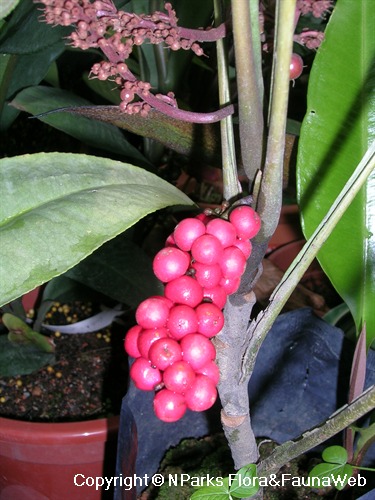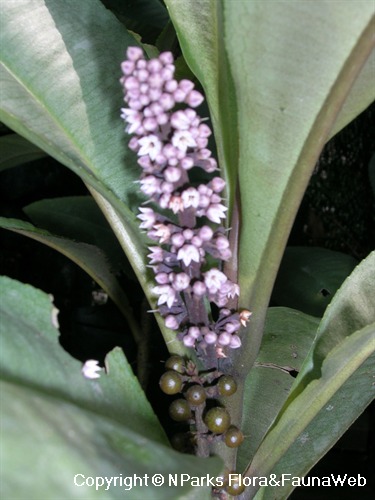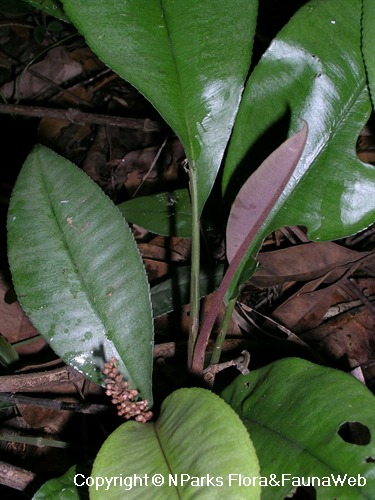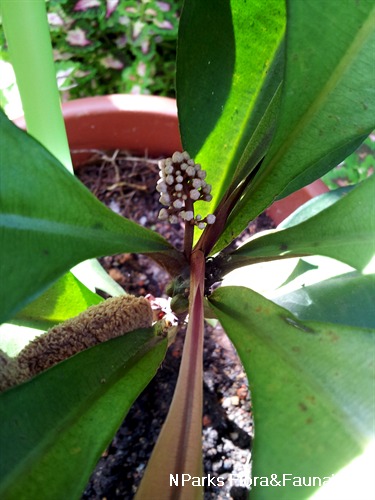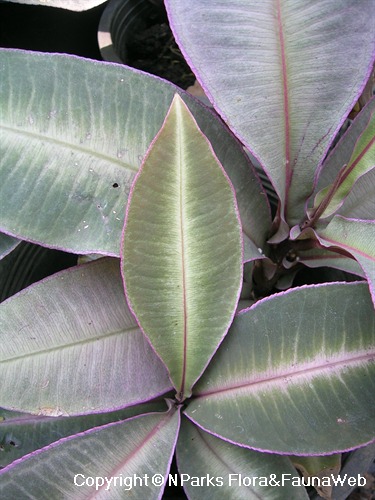.jpg)
Back
Labisia pumila (Blume) Fern.-Vill.
| Family Name: | Primulaceae |
| Common Name: | Akar Fatimah, Kunci Fatimah, Rumput Siti Fatimah, Selusoh Fatimah, Akar Kecil Fatimah, Kacip Fatimah, Pokok Pinggan, Mata Pelandok Rimba |
Name
Classifications and Characteristics
| Plant Division | Angiosperms (Flowering Seed Plants) (Dicotyledon) |
|---|---|
| Plant Growth Form | Shrub |
| Mode of Nutrition | Autotrophic |
| Maximum Height | 0.5 m |
Biogeography
| Native Distribution | Indochina, throughout Malesia & South Thailand |
|---|---|
| Local Conservation Status | Native to Singapore (Vulnerable (VU)) |
Description and Ethnobotany
| Growth Form | Herb up to 0.5 m tall. |
|---|---|
| Foliage | The plant produces dark green leaves which are lanceolate with crenulate edges (having small, rounded teeth on the edge). The leaf blade is (8-)15-25 cm long x (2.5-)5-7 cm wide and the petiole or leaf stalk is 2.5-7.5 cm long. There are no stipules or small, leafy appendages at the base of the petiole. Young foliage is black-green with a pink leaf margin. |
| Flowers | Purple or off-white, 5-petalled flowers are arranged in a spike-like inflorescence which is technically known as an axillary raceme (8 cm long). |
| Fruit | Bright red, round fruits look like berries, but are technically drupes (0.4 cm wide). |
| Ethnobotanical Uses | Medicinal: In Malaysia, plant extracts are used to help induce childbirth and promote recovery after childbirth. A study by Norhayati et al. (2014) found that Labisia pumila var. alata extracts improved mental well-being and cardiovascular health in pre- and post-menopausal women. The extracts may also protect skin from the aging effects of UVB irradiation and could potentially be used in cosmetic products (Choi et al. 2010). |
Plant Care and Propagation
| Light Preference | Semi-Shade |
|---|---|
| Water Preference | Moderate Water |
Foliar
| Mature Foliage Colour(s) | Green |
|---|---|
| Mature Foliage Texture(s) | Smooth |
| Prominent Young Flush Colour(s) | Black, Pink |
| Foliar Type | Simple / Unifoliate |
| Foliar Arrangement Along Stem | Alternate |
| Foliar Attachment to Stem | Petiolate |
| Foliar Shape(s) | Non-Palm Foliage (Lanceolate) |
| Foliar Venation | Pinnate / Net |
| Foliar Margin | Crenulate |
| Foliar Apex - Tip | Acuminate |
| Foliar Base | Acute |
| Leaf Area Index (LAI) for Green Plot Ratio | 4.5 (Shrub & Groundcover - Dicot) |
Floral (Angiosperm)
| Flower Colour(s) | Cream / Off-White, Purple |
|---|---|
| Flower Grouping | Cluster / Inflorescence |
| Flower Location | Axillary |
| Flower Symmetry | Radial |
| Individual Flower Shape | Stellate / Star-shaped |
| Inflorescence Type | Raceme |
Fruit, Seed and Spore
| Mature Fruit Colour(s) | Red |
|---|---|
| Fruit Classification | Simple Fruit |
| Fruit Type | Fleshy Fruit |
Image Repository
Others
| Master ID | 878 |
|---|---|
| Species ID | 2172 |
| Flora Disclaimer | The information in this website has been compiled from reliable sources, such as reference works on medicinal plants. It is not a substitute for medical advice or treatment and NParks does not purport to provide any medical advice. Readers should always consult his/her physician before using or consuming a plant for medicinal purposes. |

.jpg)

